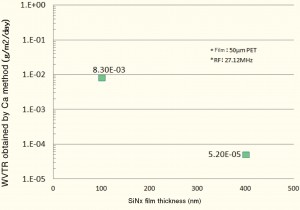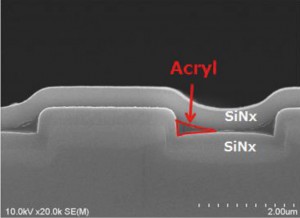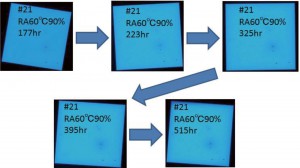This post is also available in: Japanese Chinese (Simplified)
Figure 3 is a correlation graph between the thickness of a SiNx film deposited by our PECVD equipment and its WVTR. WVTR was measured using the Ca (calcium)method13). As shown in the graph, with a SiNx thickness of 400 nm, a low WVTR (i.e., high barrier property) of 5×10-5 g/m2/day is obtained. There are indications that achieving the same barrier property with a SiNx film deposited by another company’s PECVD equipment would require a film thickness of 1 μm or more. This high barrier property has been obtained thanks to a hardware configuration designed on the basis of extensive experience and optimization of processes. The results of FT-IR analysis revealed a low concentration of residual hydrogen in the SiNx film.
It has been reported that residual hydrogen interacts with moisture and oxygen and thereby degrades the barrier property15). This is considered to be due to the creation of the SiNx film, which has little interaction with the moisture and oxygen in the atmosphere.


Acrylic’s characteristic of localizing at a stepped portion is dependent on the acrylic monomer material. Our monomer material can hold the acrylic at the device’s corners or in narrow gaps using surface tension. On the other hand, other companies’ acrylic monomer materials are deposited over the entire surface without localizing. Figure 4 is an image showing localization of acrylic film at a stepped portion. As seen in this picture, acrylic film attached after deposition of a SiNx film on the first layer is localizing at the stepped portion in the trench, and helps the upper-layer SiNx film be deposited with good coverage.
Although SiNx film has a high barrier property, it has inferior coverage on device’s corners or in narrow gaps where moisture and oxygen permeate and reduce the device’s WVTR. However, localization of acrylic allows better coverage of the upper-layer SiNx film (Figure 4) and thereby results in achievement of excellent encapsulation performance by our thin film encapsulation technology.

Figure 5 shows the results of observation of emission states where a thin-film encapsulated OLED device provided by our company is stored for 500 hours in a high temperature and high humidity environment at 60℃ and at 90% relative humidity (90% RH). Dark spots would appear at places where moisture or oxygen in the atmosphere permeated through the encapsulation film and reached the OLED device, but no dark spots appeared in the device in the figure. The mechanism by which dark spots appear is as follows: moisture/oxygen-sensitive cathode materials (material based on Al, Mg/Ag, Li, etc.) in the top layer of the OLED device contact and react with moisture or oxygen, and become electrically insulated.
Dark spots start appearing in places with insufficient en-capsulation performance (where moisture or oxygen get in), and with a growing inflow of moisture and oxygen as time progresses, the spotted area expands. Regarding the device in Figure 5, no new dark spots appeared after initiation of the storage under the high temperature and high humidity environment, and the areas of the dark spots remained the same. It can be said from these results that our thin film encapsulation technology can provide sufficient encapsulation performance. Also, it is said that a test in a high temperature and high humidity environment at 60℃ and 90% RH is comparable to a test at 25℃ and 50% RH with time accelerated 10–100 times3).
